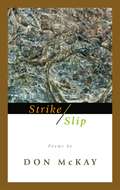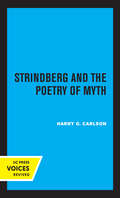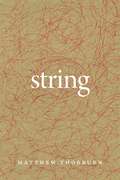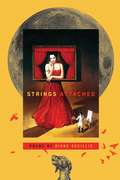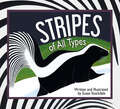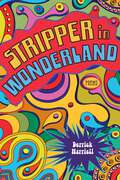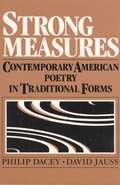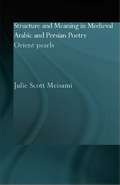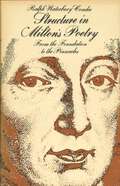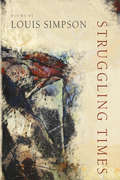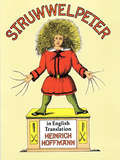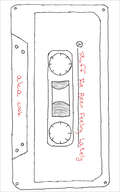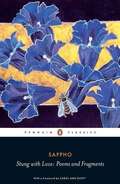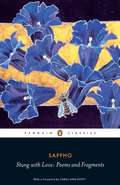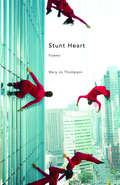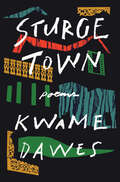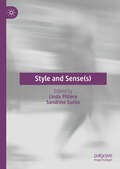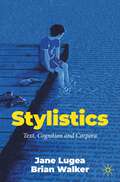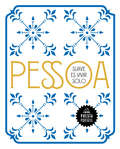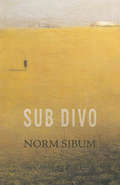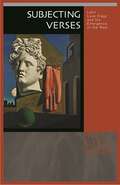- Table View
- List View
Strike/Slip
by Don MckayIn this extraordinary collection from one of our most celebrated poets, Don McKay walks the strike-slip fault between poetry and landscape, sticks its strange nose into the cold silence of geologic time, meditates on marble, quartz and gneiss, and attends to the songs of ravens and thrushes and to the clamour of the industrialized bush. Behind these poems lies the urge to engage the tectonics of planetary dwelling with the rickety contraption of language, and to register the stress, sheer and strain -- but also the astonishment -- engendered by that necessary failure.
Strindberg and the Poetry of Myth
by Harry G. CarlsonThis title is part of UC Press's Voices Revived program, which commemorates University of California Press’s mission to seek out and cultivate the brightest minds and give them voice, reach, and impact. Drawing on a backlist dating to 1893, Voices Revived makes high-quality, peer-reviewed scholarship accessible once again using print-on-demand technology. This title was originally published in 1982.
String (Barataria Poetry)
by Matthew ThorburnA book-length sequence of poems, Matthew Thorburn’s String tells the story of a teenage boy’s experiences in a time of war and its aftermath. He loses his family and friends, his home and the life he knew, but survives to tell his story. Written in the boy’s fractured, echoing voice—in lines that are frequently enjambed and use almost no punctuation—String embodies his trauma and confusion in a poetic sequence that is part lullaby, part nightmare, but always a music that is uniquely his.
Strings Attached
by Diane DecillisIn Strings Attached, poet Diane DeCillis takes inspiration from the story of the elephant calf with a thin rope tied to its leg. Even when it grows into a massive animal, the elephant thinks the same string still restrains it and never attempts to break free. This powerful, funny, and sometimes self-deprecating collection considers all the ways that strings bind us in relationships and explores their constant tightening and loosening. Although we may never sever the strings attached to our wounds, DeCillis shows that when given enough slack we can create the illusion of having been set free. The poems in Strings Attached consider tension in a variety of relationships. The short string of an American girl raised in Detroit by a resentful Lebanese grandmother whose culture values boys over girls. The attachment to a strong mother who exemplifies feminism but who is mostly absent in order to support the family. The cosmopolitan father who abandons but captivates, and the strings of relationships with older men, built on longing for the missing father. The long strings of a secret life that teach you to be distant. The strings that cuff you to your home, and the triumph of loosening them after years of agoraphobia. The frayed strings that come from being too American in a Lebanese culture. The strings of food and tradition that connect to family and friends. DeCillis's verse reflects an insistent search for identity and the happy discovery that outsider status can be a good thing, a kind of earned badge that provides new ways of seeing. All poetry readers will relate to the personal and perceptive verse of this debut collection.
Stripes of All Types
by Susan StockdaleA patterned parade of animals comes to life! What kinds of animals have stripes and why do they have them? With engaging rhymes and bright, bold images, award-winning author-illustrator Susan Stockdale introduces readers to a range of striped animals, familiar and exotic, and some of the benefits of their patterns. In addition to providing beauty and inspiration, stripes can help a creature communicate with and recognize fellow members of its species, provide camouflage for hunting or hiding, or confuse or scare off predators. From the tiger to the Malaysia tapir, the ring-tailed lemur to the zebra, these stunning striped creatures will delight and fascinate budding naturalists. This entrancing companion to Spectacular Spots features energetic rhyming text and beautifully detailed paintings that pop off the page. An afterword tells a little bit more about each animal and where it lives, and readers can test their knowledge of animal stripes with a fun matching game at the end.
Stripper in Wonderland: Poems (Southern Messenger Poets)
by Derrick HarriellThe percussive poems of Stripper in Wonderland move from birth to death, funk to hip-hop, and racism to religion as Derrick Harriell explores the life of a modern black man transplanted from the American Midwest to the Deep South.Harriell summons the ghosts of the past as he deals with the realities of the present. He carefully winds images and words together to produce powerful, often graphic, poems that inform our view of one another as they punch through our assumptions.
Strong Measures: Contemporary American Poetry in Traditional Forms
by David Jauss Philip DaceyThis anthology helps instruct poets, and students of poetry, in the techniques of formal verse, so that the beauty and power of traditional forms will not be lost to future generations.
Strong and True 3rd Edition
by Laurel HicksSelections from the Bible, Aesop, Longfellow, and Stevenson are among the character-building stories and poems in this reader. Exercises to improve vocabulary and reading comprehension skills are included.
Structure and Meaning in Medieval Arabic and Persian Lyric Poetry: Orient Pearls (Culture and Civilization in the Middle East)
by Julie MeisamiThis is the first comprehensive and comparative study of compositional and stylistic techniques in medieval Arabic and Persian lyric poetry. Ranging over some seven countries, it deals with works by over thirty poets in the Islamic world from Spain to present-day Afghanistan, and examines how this rich poetic traditions exhibits both continuity and development in the use of a wide variety of compositional strategies. Discussing such topics as principles of structural organisation, the use of rhetorical figures, metaphor and images, and providing detailed analyses of a large number of poetic texts, it shows how structural and semantic features interacted to bring coherence and meaning to the individual poem. It also examines works by the indigenous critics of poetry in both Arabic and Persian, and demonstrates the critics' awareness of, and interest in, the techniques which poets employed to construct poems which were both eloquent and meaningful. Comparisons are also made with classical and medieval poetics in the west. The book will be of interest not merely to specialists in the relevant fields, but also to all those interested in pre-modern poetry and poetics.
Structure in Milton's Poetry
by Ralph W. CondeeMilton's skill in constructing poems whose structure is determined, not by rule or precedent, but by the thought to be expressed, is one of his chief accomplishments as a creative artist. Professor Condee analyzes seventeen of Milton's poems, both early and late, well and badly organized, in order to trace the poet's developing ability to create increasingly complex poetic structures.Three aspects of Milton's use of poetic structure are stressed: the relation of the parts to the whole and parts to parts, his ability to unite actual events with the poetic situation, and his use and variation of literary tradition to establish the desired structural unity.
Structure in Milton's Poetry
by Ralph W. CondeeMilton's skill in constructing poems whose structure is determined, not by rule or precedent, but by the thought to be expressed, is one of his chief accomplishments as a creative artist. Professor Condee analyzes seventeen of Milton's poems, both early and late, well and badly organized, in order to trace the poet's developing ability to create increasingly complex poetic structures.Three aspects of Milton's use of poetic structure are stressed: the relation of the parts to the whole and parts to parts, his ability to unite actual events with the poetic situation, and his use and variation of literary tradition to establish the desired structural unity.
Struggling Times (American Poets Continuum)
by Louis SimpsonPulitzer Prize–winning poet Louis Simpson has been a leading figure in American letters for more than half a century. Born in the West Indies, Simpson immigrated to the United States at the age of seventeen. He studied at Columbia University, then served the US Army in active duty in Europe during World War II. After the war he continued his studies at Columbia and at the University of Paris. While living in France, he published his first book of poems, The Arrivistes (1949).The poems in Struggling Times find Simpson’s distinct imaginative voice working at its full poetic power. Both timely and personal, the poems reveal Simpson’s ongoing quarrel with suburban America, as well as the American government’s struggle to retain its integrity and honor in the midst of its own aggression and worldwide strife.You have to be carefulwhat you hear or see.In Afghanistan I sawthe man and the womanwho were caught in adulteryburied up to their heads.Their children were broughtand told to throw stones.I can still see the headstwisting on the ground.The poor devil in Papillonwith his head in the guillotine . . .but Goya’s half-buried doglooking up at the skyI think was the worst of all."This is the Jamaican-born Simpson's 18th collection; its dry trimeters and tragic resignations should certainly please the faithful fans... Yet the new poems, as much as any in his oeuvre, leave room for unexpected happiness...Simpson believes in endurance and the rewards of the ordinary. He can, at his best, make his readers believe in those things too." --Publishers WeeklyLouis Simpson’s last book, The Owner of the House: New Collected Poems 1940-2001, (BOA Editions, Ltd., 2003) was finalist for the National Book Award and the Griffin Poetry Prize. His other honors include the Prix de Rome, Guggenheim Foundation fellowships, and the Columbia Medal for Excellence.
Struwwelpeter in English Translation
by Heinrich HoffmannFirst published in 1845. Struwwelpeter (variously translated as "slovenly" or "shock-headed" Peter) has become widely recognized as one of the most popular and influential children's books ever written. Heinrich Hoffmann was a Frankfurt physician. Unhappy with the dry and pedagogic books available for children at the time, he wrote and illustrated Struwwelpeter as a Christmas present for his three-year-old son. The book relates in verse and pictures the often gruesome consequences that befall children who torment animals, play with matches, suck their thumbs, refuse to eat, fidget at meals, etc.Written in rhyming couplets and illustrated by the author, the book was an immediate success. It has since gone through hundreds of editions and been published in almost every European language. The present volume reprints 25 color plates from a German edition (including a bonus plate done for the 100th edition in 1876) with the reset text of a standard English translation. Also included are the full German text and an afterword with a brief biography of the author and note on how the book came to be written.Children, bibliophiles, antiquarians--any lover of time-honored tales for children--will welcome this new edition of the classic German story. Content is optimized for tablet.
Stuff I've Been Feeling Lately
by Alicia CookStructured like an old-school mix-tape, Stuff I've Been Feeling Lately is Alicia Cook's lyric message to anyone who has dealt with addiction. <P><P> "Side A" touches on all aspects of the human condition: life, death, love, trauma, and growth. <P>"Side B" contains haunting black-out remixes of those poems.
Stuff I've Been Feeling Lately
by Alicia CookStructured like an old-school mix-tape, Stuff I've Been Feeling Lately is Alicia Cook's lyric message to anyone who has dealt with addiction. "Side A" touches on all aspects of the human condition: life, death, love, trauma, and growth. "Side B" contains haunting black-out remixes of those poems.
Stung With Love: Poems and Fragments
by Sappho Aaron Poochigian Carol Ann DuffyMore or less 150 years after Homer's Iliad, Sappho lived on the island of Lesbos, west off the coast of what is present Turkey. Little remains today of her writings, which are said to have filled nine papyrus rolls in the great library at Alexandria some 500 years after her death. The surviving texts consist of a lamentably small and fragmented body of lyric poetry—among them poems of invocation, desire, spite, celebration, resignation and remembrance—that nevertheless enables us to hear the living voice of the poet Plato called the tenth Muse. This is a new translation of her surviving poetry.
Stung with Love: Poems and Fragments of Sappho
by SapphoMore or less 150 years after Homer's Iliad, Sappho lived on the island of Lesbos, west off the coast of what is present Turkey. Little remains today of her writings, which are said to have filled nine papyrus rolls in the great library at Alexandria some 500 years after her death. The surviving texts consist of a lamentably small and fragmented body of lyric poetry - among them poems of invocation, desire, spite, celebration, resignation and remembrance - that nevertheless enables us to hear the living voice of the poet Plato called the tenth Muse. This is a new translation of her surviving poetry.
Stunt Heart (The Backwaters Prize in Poetry)
by Mary Jo ThompsonIn Stunt Heart, Mary Jo Thompson’s debut collection,a female gaze locates the ironies inside the subjects of marriage and death, loneliness and love, speaking and silence. The title plays on both sick hearts and circus tricks, and appropriately, these poems are direct, personal, and disarmingly emotive. Look at the end of the first poem, “Says Penelope,” where the speaker suddenly veers to “Newsflash: I sleep- / walk.” These stark moments of admission are used to perfection in the centerpiece sonnet series, “Thirteen Months,” the collection’s highlight. Distilled emotion over the illness and death of an estranged husband ranges in tone from the dark humor that compares the marriage to a used car to the elegiac imagery of protecting the family garden from frost. The shock of seeing the deceased in his casket looking like a cross between Clark Gable and Dracula seasons the collection, recurring in ruminations on the various ways a body is prepared at death and the story of a mother who dies while sneezing. Although no one brings back the dead by writing poetry, in Stunt Heart,Thompson revisits them with credible humor and tough dispatches from bedrooms, graveyards, and hospital hallways. Thompson’s Stunt Heart jukes, dodges, and prays while muscling through all manners of demise and in the process reveals how one can turn grief into speech, art into grieving.
Sturge Town: Poems
by Kwame DawesIn this stunning volume, acclaimed poet Kwame Dawes explores the mythic, ancestral, and spiritual journeys that make up a life. The site of the ruined ancestral home of Kwame Dawes’s family, in one of the earliest post-slavery free villages in Jamaica, Sturge Town is at once a place of myth and, for Dawes, a metaphor of the journeying that has taken him from Ghana, through Jamaica, and to the United States. The poet ranges through time, pursued by a keen sense of mortality, and engages in an intimate dialogue with the reader—serious, confessional, alarmed, and sometimes teasing. Metrically careful and sonorous, these poems engage in a personal dialogue with the reader, serious, confessional, alarmed and sometimes teasing. They create highly visualized spaces, observed, remembered, imagined, the scenes of both outward and inner journeys. Whether finding beauty in the quotidian or taking astonishing imaginative leaps, these poems speak movingly of self-reflection, family crises, loss, transcendence, the shattering realities of political engagement, and an unremitting investment in the vivid indeterminacy of poetry.
Style and Sense(s)
by Sandrine Sorlin Linda PillièreThis edited volume celebrates cutting-edge research in stylistics and, more specifically, recent work on sense and the senses. The title originated in the Poetics and Linguistics Association (PALA) 2022 conference and marks the 40th onsite event by showcasing some of the excellent papers delivered on that occasion. The selected chapters fall into 4 parts each of which gives pride of place to how style makes sense and how senses make style. The chapters follow research in neuroscience and sociocognition, investigate how body and mind are inextricably linked through embodied meaning; how emotions are both conveyed and perceived; and how impressions, thoughts and worldviews can be induced by a certain style. The apprehension of the senses is carried through a variety of theories (cognitive linguistics and stylistics, ecostylistics, phenomenology, simulation theory, enactivism, metaphor theory, Text World Theory) and is applied to various genres (poetry, novels, short stories, detectivefiction, restaurant reviews) and media (the oral vs written tradition, ekphrasis, and semiotic transfers). This book will be of interest to students and academics in stylistics, cognitive linguistics, discourse analysis, ecostylistics, and multimodality.
Stylistics: Text, Cognition and Corpora
by Brian Walker Jane LugeaThis textbook introduces the reader to contemporary approaches to language analysis such as cognitive stylistics and corpus stylistics, reflecting recent shifts in research trends and offering students a practical way to access and understand these developments. The authors lead readers through detailed explanations, guided analyses, examples of research and suggestions for further reading. This textbook makes an ideal introduction to the field of stylistics for students who are new to the area, but who have some background in basic language analysis. It will be of use to students on courses in stylistics, literary linguistics, corpus methods, cognitive linguistics, and language and style.
Suave es vivir solo (Flash Poesía #Volumen)
by Fernando PessoaLa colección «Poesía Portátil» reúne en Suave es vivir solo una muestra de los versos más rompedores de Fernando Pessoa, creador de una obra dominada por el vanguardismo y las identidades múltiples. Fernando Pessoa es considerado, junto con Luis de Camões, el poeta más importante en lengua portuguesa y uno de los más reconocidos de la literatura universal. Álvaro de Campos, Ricardo Reis y Alberto Caeiro son algunos de sus heterónimos, verdaderas personalidades poéticas con estilo propio, personajes completos, con biografías propias y estilos literarios dispares. Se convirtieron así en máscaras del propio escritor, en las que se despersonalizó para dar forma, a través de sus múltiples voces, a la amplitud y complejidad de sus pensamientos, conocimientos, y percepciones de la vida y el mundo. -------«El poeta es un fingidor.Finge tan completamenteque hasta finge que es dolorel dolor que en verdad siente.»-------
Sub Divo
by Norm SibumThe most famous use of the phrase sub divo appears in Horace's ode on patriotism, in which the poet enjoins the young to embrace the military, to suffer poverty, and, in a life of service to the nation, be sub divo ("under the sky").In this collection of poems, however, Norm Sibum suggests that we are all of us sub divo, no matter who or what we are. Living under a sky from which there is no escape, with the "conversion of value to parody almost complete," our poets are as likely to be fascists as they are rebels or conscientious objectors. "Shall we talk it up," he asks his friend Foulard: "how we're isolate / In our skins ... Harps strung for satire and plunging tears?"Personal, epistolary, corrosive, vented with Sibum's classical spleen and explosive prosody, Sub Divo delves into the "slap-happy passion" and the "colonial, scrappy, boisterous business" of American culture-while at the same time asking what future there is for a world "divided even now / In the only places where we cohere," when "all the disparate pieces drifting in us / Pine one for the other and look / For the ceremony that will join them."
Subhuman Redneck Poems
by Les MurrayIn this collection of poems, farmers, fathers, poverty-stricken pioneers, and people blackened by the grist of the sugar mills are exposed to the blazing midday sun of Murray's linguistic powers. Richly inventive, tenderly perceptive, and fiercely honest, these poems surprise and bare the human in all of us.
Subjecting Verses: Latin Love Elegy and the Emergence of the Real
by Paul Allen MillerThe elegy flared into existence, commanded the cultural stage for several decades, then went extinct. This book accounts for the swift rise and sudden decline of a genre whose life span was incredibly brief relative to its impact. Examining every major poet from Catullus to Ovid, Subjecting Verses presents the first comprehensive history of Latin erotic elegy since Georg Luck's. Paul Allen Miller harmoniously weds close readings of the poetry with insights from theoreticians as diverse as Jameson, Foucault, Lacan, and Zizek. In welcome contrast to previous, thematic studies of elegy--efforts that have become bogged down in determining whether particular themes and poets were pro- or anti-Augustan--Miller offers a new, "symptomatic" history. He asks two obvious but rarely posed questions: what historical conditions were necessary to produce elegy, and what provoked its decline? Ultimately, he argues that elegiac poetry arose from a fundamental split in the nature of subjectivity that occurred in the late first century--a split symptomatic of the historical changes taking place at the time. Subjecting Verses is a major interpretive feat whose influence will reach across classics and literary studies. Linking the rise of elegy with changes in how Romans imagined themselves within a rapidly changing society, it offers a new model of literary theory that neither reduces the poems to a reflection of their context nor examines them in a vacuum.
